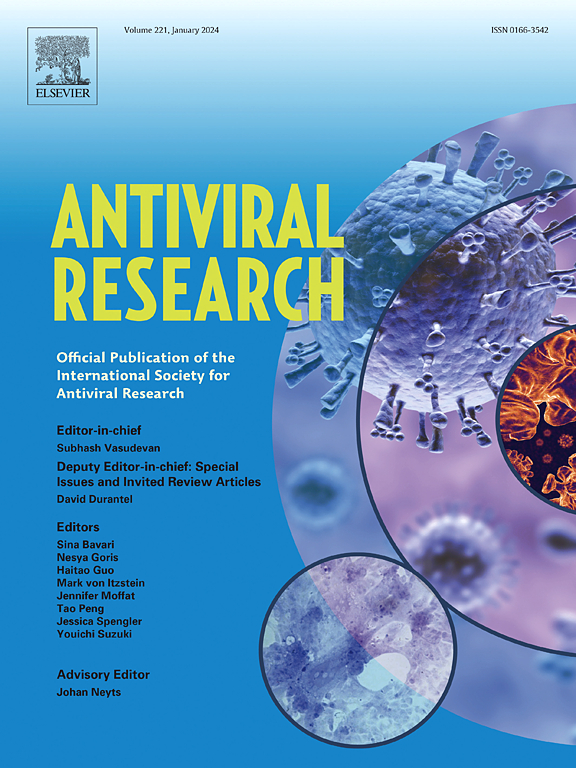A novel cellular tool for screening human pan-coronavirus antivirals
IF 4.5
2区 医学
Q1 PHARMACOLOGY & PHARMACY
引用次数: 0
Abstract
Severe acute respiratory syndrome coronavirus 2 (SARS-CoV-2) remains a pressing global threat, having emerged in December 2019. Alongside it, Middle East respiratory syndrome coronavirus (MERS-CoV), a highly pathogenic human coronavirus, was identified in 2012 and continues to cause seasonal outbreaks in the Middle East. The persistence of these deadly human coronaviruses underscores the need for ongoing research on broad-spectrum antivirals. Human alveolar A549 cells have been widely used to study respiratory virus infections; however, there is a lack of standardized cell models that are permissive to these diverse lethal coronaviruses. To facilitate the assessment and validation of antiviral treatments, a robust human cell model that is susceptible to SARS-CoV-2, MERS-CoV, and other human coronavirus family members is indispensable. SARS-CoV-2 uses the angiotensin converting enzyme 2 (Ace2) receptor for entry and transmembrane serine protease 2 (Tmprss2) to prime its spike protein, while MERS-CoV relies on the dipeptidyl peptidase 4 receptor (Dpp4) for cellular entry, both of which are minimally expressed in A549 cells. In this study, we fine-tuned the expression levels of each receptor for optimal viral entry and infectivity using lentiviral transduction, cell sorting and clone selection. We successfully developed a robust human cell model expressing multiple viral receptors and demonstrated its susceptibility to both lethal coronaviruses and seasonal human coronaviruses, OC43 and 229E. We also compared two known 3C-like protease inhibitors and found that Nirmatrelvir is superior to Pomotrelvir in terms of pan-coronavirus antiviral activity. Furthermore, we tested 13 known antimalarial drugs and identified Halofantrine as having antiviral activity against SARS-CoV-2. Our findings suggest that this novel human cell model is a valuable and versatile tool for the screening and identification of pan-CoV antiviral drugs.
筛选人类泛冠状病毒抗病毒药物的新型细胞工具。
严重急性呼吸综合征冠状病毒2 (SARS-CoV-2)于2019年12月出现,仍然是一个紧迫的全球威胁。此外,中东呼吸综合征冠状病毒(MERS-CoV)是一种高致病性人类冠状病毒,于2012年被发现,并继续在中东引起季节性疫情。这些致命的人类冠状病毒的持续存在强调了对广谱抗病毒药物进行持续研究的必要性。人肺泡A549细胞已被广泛用于呼吸道病毒感染的研究;然而,缺乏允许这些不同致命冠状病毒的标准化细胞模型。为了促进抗病毒治疗的评估和验证,一个对SARS-CoV-2、MERS-CoV和其他人类冠状病毒家族成员敏感的强大的人类细胞模型是必不可少的。SARS-CoV-2利用血管紧张素转换酶2 (Ace2)受体进入,利用跨膜丝氨酸蛋白酶2 (Tmprss2)启动刺突蛋白,而MERS-CoV则依靠二肽基肽酶4受体(Dpp4)进入细胞,这两种受体在A549细胞中表达量最低。在这项研究中,我们通过慢病毒转导、细胞分选和克隆选择,微调了每个受体的表达水平,以获得最佳的病毒进入和传染性。我们成功地建立了一个表达多种病毒受体的强大的人类细胞模型,并证明了它对致命冠状病毒和季节性人类冠状病毒OC43和229E的易感性。我们还比较了两种已知的3c样蛋白酶抑制剂,发现Nirmatrelvir在泛冠状病毒抗病毒活性方面优于Pomotrelvir。此外,我们测试了13种已知的抗疟疾药物,并确定Halofantrine对SARS-CoV-2具有抗病毒活性。我们的研究结果表明,这种新的人类细胞模型是筛选和鉴定泛冠状病毒抗病毒药物的一种有价值的通用工具。
本文章由计算机程序翻译,如有差异,请以英文原文为准。
求助全文
约1分钟内获得全文
求助全文
来源期刊

Antiviral research
医学-病毒学
CiteScore
17.10
自引率
3.90%
发文量
157
审稿时长
34 days
期刊介绍:
Antiviral Research is a journal that focuses on various aspects of controlling viral infections in both humans and animals. It is a platform for publishing research reports, short communications, review articles, and commentaries. The journal covers a wide range of topics including antiviral drugs, antibodies, and host-response modifiers. These topics encompass their synthesis, in vitro and in vivo testing, as well as mechanisms of action. Additionally, the journal also publishes studies on the development of new or improved vaccines against viral infections in humans. It delves into assessing the safety of drugs and vaccines, tracking the evolution of drug or vaccine-resistant viruses, and developing effective countermeasures. Another area of interest includes the identification and validation of new drug targets. The journal further explores laboratory animal models of viral diseases, investigates the pathogenesis of viral diseases, and examines the mechanisms by which viruses avoid host immune responses.
 求助内容:
求助内容: 应助结果提醒方式:
应助结果提醒方式:


